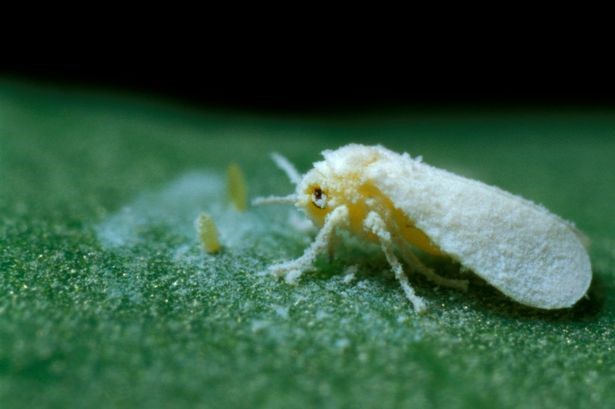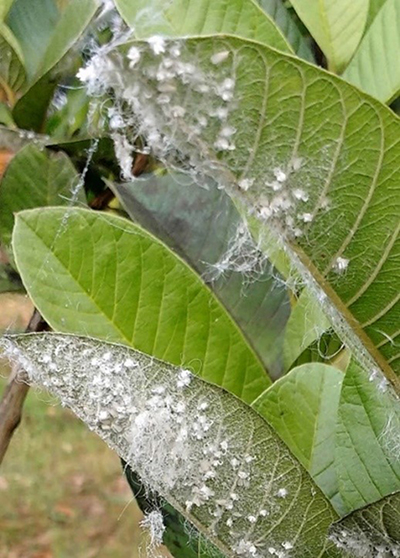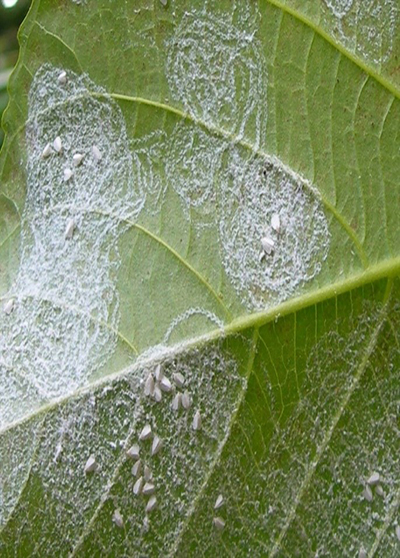|
PREVENTION OF WHITEFLY ON GUAVA TREES
21/06/2023
PREVENTION OF WHITEFLY ON GUAVA TREES Currently, the Mekong Delta has a relatively high area of guava cultivation. Because guava is an easy-to-grow, give fruit, often chosen to be intercropped with other plants in the garden or grown in a specialized form. Many delicious varieties of guava such as Queen guava, purple guava, seedless guava, Taiwanese guava, etc. Due to high economic efficiency, the guava growing area is increasingly expanding. Guava trees are often attacked by many pests, in which whitefly is a fairly common pest in the Mekong River Delta region, causing quite heavy damage on guava trees, significantly affecting yield and quality. of fruit, reducing costs, and farmers income.
Symptoms of whitefly damage on guava trees. Whitefly lays eggs on guava leaves in spirals Whitefly is a very common sucking insect on many crops and also causes quite a lot of damage on guava trees.Whitefly has the scientific name Aleurodicus dispersus, belongs to the family Aleyrodidae.Adults are small, about 1.5-2mm long, have two pairs of white wings, short antennae,young hoppers have white tentacles covering the body.Whitefly lays eggs on the underside of leaves, scattered in spiral circles and covered with fine white waxy hairs, each spiral has about 15 to 25 eggs. Eggs are about 0.5 mm long. About a week after laying, the eggs hatch into young hoppers. - The young hopper stage consists of 4 years old and lasts about 1 month. The young hoppers secrete white waxy fibers all around the body, these waxy tendrils give the underside of the leaves a white powdery coating. - Both adult and young hoppers are concentrated on the underside of leaves sucking sap. They cling to young buds, young leaves, on fruits (especially young ones) causing young buds, young leaves to be curled, young fruits may fall. If it is heavy, it will affect the yield and quality of guava. In addition, the waste of whitefly contains bile, which is a favorable environment for soot fungi to grow, reducing the photosynthetic area of leaves, thereby affecting the growth and development of plants. - Whitefly has many natural enemies such as parasitic wasps, carnivorous flies, nettle beetles, white ladybugs, parasitic fungi, etc.
Image: The life cycle of the white hopper Aleurodicus dispersus To prevent whitefly, some measures should be applied: - Do not plant too thick guava, regularly prune and remove diseased branches, branches hidden in the foliage, old branches that cannot bear fruit so that the garden is always open. - Regularly clean up the grass, trash, and rotten leaves around the base to break the habit of foul ants living in symbiosis with whitefly. - Using a water pump with high pressure to spray water strongly on the places where there are many hoppers clinging will have the effect of washing away the hoppers. - Regularly visit the garden to detect and spray insecticides to kill leafhoppers in a timely manner, especially in the period when the tree is having young buds, young leaves, flowers and fruits. Spray a combination of Osago 80 WG (Pymetrozine 60% + Nitenpyram 20% w/w) and SK Enspray 99 EC mineral oil with the recommended dose: Mix a pack of Osago 80WG/15gr + 40ml SK EnSpray mineral oil for a 25 liter water bottle + Osago 80WG (Pymetrozine 60% + Nitenpyram 20% w/w) is a mixture of drugs to prevent groups of sucking insects such as aphids, aphids, thrips, etc. Because both active ingredients directly affect the system. When the insect nerve is hit by the drug, the hopper immediately stops stinging and stops transmitting viral diseases. Osago 80WG has drainage, deep penetration, contact and toxic taste, is quickly absorbed by the plant, is less washed away, takes a long time to decompose, has a long-lasting effect, so it is highly effective to prevent hoppers and is less expensive because it has to be sprayed. again. + SK EnSpray 99 EC mineral oil is a high quality mineral oil extracted from crude oil distillation technology to prevent pests on many crops, effective on stinging insects such as spiders, thrips, mealybugs , hoppers, worms draw charms, ... Note: Guava is a fruit that is eaten fresh and has many stages of large, small or flowering fruit on the tree, so when mixing the mixture before spraying, pay attention to the following: Put ½ of water in the bottle, then mix the insecticide first, stir gently to dissolve. SK EnSpray mineral oil mix 40ml separately with the remaining amount of water, then pour it into a bottle to gently stir the mixture, spray it in the early morning or late afternoon. Avoid spraying SK EnSpray mineral oil higher than the recommended dose, it will affect plants especially when young buds, young fruits and when flowering.
|
To prevent, in addition to plowing and burying weed seeds, collecting weed stalks and stumps left after tilling the land to burn, not letting weeds produce seeds in production fields, etc., the use of chemical products is still a measure. optimal because of its ability to thoroughly kill weeds, reduce labor and take advantage of more time than manual weeding.
Miner has the scientific name Phyllocnistis citrella Staint., family Phyllocnistidae, order Lepidoptera. The miner occurs in many countries in the tropics and subtropics. The main host of the miner is the citrus family - Rutaceae. In addition, the miner also attacks mangosteen and some other plants.
Adult is a small planthopper, with a body 2-3 mm long, the whole body is ash gray, slightly greenish, the wings are opaque with many small brown spots.Eggs are oval, 0.3 mm long, have a pointed end and are attached directly to the leaf surface, leaf axils.
Green bugs specialize in the fruit of citrus groups (oranges, tangerines, lemons, grapefruits, kumquats...), some people call them orange bugs, or orange suckers. Their scientific name is Rhynchocoris poseidon or Rhynchocoris humeralis.
In Vietnam, yellow leaf curl disease is very common on papaya trees, especially the disease is often severe in areas of high and continuous planting, areas with hot and arid climates. The disease has significantly reduced the yield and quality of papaya. Gardens that are infected early when the plants are young may not yield. However, up to now, many gardeners still do not know the cause and how to fix it.
Spider mites are common pests on citrus trees, especially in hot and dry climates that are suitable for spiders to grow and cause severe damage.The group of harmful spiders is usually very small in size, unlike the natural enemy spiders.
This group includes species that are generally very small in size, causing damage by sucking plant sap (on leaves, fruits, branches, stems).
There are many species of mealybugs present on the group of Oranges,Tangerines,Grapefruits and Lemons (Citrus), which can be divided into 2 groups:
+ Group of sticky mealybugs with common varieties such as Lepidosaphes, Aonidiella, Coccus and Saissetia.
+ Group of flower mealybugs with common genera and species such as Pseudococcus, Planococcus and Icerya purchasi.
Dry branches and berries disease often appear to be common damage on coffee gardens during the rainy season. The disease causes death of branchs, dry fruit, severely affects the canopy structure and coffee yield if not paid attention to prevention.
Pink disease commonly causes diseases on rubber plantations in the rainy season, especially on garden from 4-8 years old. This year, rubber has to go through a period of severe drought, weakening the tree, so now in tnshe rainy season it is easy to get infected. Therefore, it is necessary to pay attention to good management to avoid affecting the garden.
In recent years, the area of citrus has been expanded because it is a fruit tree with high economic efficiency. However, in order to sell at a high price, not only in quality but consumers also require the external beauty of the fruit, so pest management on citrus is a matter of great concern to farmers. The hot season is a favorable condition for thrips to develop and cause damage, affecting the commercial value of fruit.
- Headquarters
- SAIGON PLANT PROTECTION JOINT STOCK COMPANY
- RQ 1, Nguyen Van Quy St., Tan Thuan Ward, HCM City
- Tax code: 0300632232
- Tel: (028) 38 733 295 - 38 732 077
- Fax: (028) 38 733 003 - 38 733 391
- Website: www.spchcmc.vn - Email: info@spchcmc.vn
- SAIGON PLANT PROTECTION COMPANY
- SAIGON PLANT PROTECTION JOINT STOCK ENTERPRISE
- Lot C1-C3 Hiep Phuoc Industrial Park, Hiep Phuoc Commune, HCM City
- Tel: (028) 3873 4089 - Fax: (028) 3873 4086
- Affiliated Unit
-
- Quick Links
- Home
- About us
- Career Opportunities





.jpg)
.jpg)









